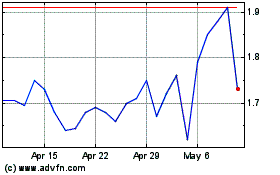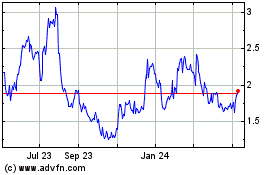Company provides 2020 product revenue guidance
range of $89 million to $93 million representing growth of
approximately 20% to 25% over preliminary 2019 full year
results
Cerus Corporation (Nasdaq:CERS) announced today preliminary
product revenue for the fourth quarter and full year 2019 and
provided 2020 product revenue guidance.
Cerus’ unaudited preliminary product revenue for the fourth
quarter of 2019 totaled $20.9 million, an increase of 27%, compared
to the $16.5 million recognized during the same period in the prior
year. Based on its fourth quarter unaudited preliminary product
revenue, the Company expects full year 2019 product revenue of
$74.6 million, at the top end of the Company’s most recent 2019
product guidance range of $72 million to $75 million. The
preliminary product revenue results have not been audited and are
subject to change.
Preliminary fourth quarter product revenue would represent the
highest quarterly product revenue ever reported by Cerus.
“We finished 2019 with momentum with preliminary fourth quarter
product revenue up 27% driven by strong INTERCEPT platelet kit
demand in North America and platelet and plasma kit demand in EMEA.
We expect the robust sales growth experienced during the past year
to continue into 2020 driven in part by the need for U.S. blood
centers and hospitals to comply with the final FDA guidance
document on bacterial safety,” said William ‘Obi’ Greenman, Cerus’
president and chief executive officer.
“We are looking forward to an exciting year as we continue to
help our blood center partners safeguard their blood component
production against known and unknown infectious disease. With the
planned increase in product revenue and margins, and continued
leverage we expect from our SG&A investments, we anticipate
lower cash use from operations during 2020 compared to 2019. In
addition, we are looking forward to the anticipated expansion of
our product portfolio with our first biologic therapeutic product,
pathogen-reduced cryoprecipitate, which has been granted FDA
breakthrough device designation for the treatment of critically
bleeding patients. An anticipated U.S. regulatory submission is
planned for the first half of 2020, with a potential approval
decision in the second half of the year,” continued Greenman.
Given the 2019 strength and anticipated increase in platelet kit
demand as U.S. blood centers become compliant with the FDA guidance
document, the Company expects full year 2020 product revenue will
be in the range of $89 million to $93 million, representing growth
of approximately 20% to 25% compared to preliminary unaudited 2019
full year results.
Cerus will provide complete fourth quarter and full year 2019
financial results and host a call to discuss both 2019 results and
2020 expectations in late February.
ABOUT CERUS
Cerus Corporation is dedicated solely to safeguarding the
world’s blood supply and aims to become the preeminent global blood
products company. Based in Concord, California, our employees are
dedicated to deploying and supplying vital technologies and
pathogen-protected blood components for blood centers, hospitals
and ultimately patients who rely on safe blood. With the INTERCEPT
Blood System, we are focused on protecting patients by delivering
the full complement of reliable products and expertise for
transfusion medicine. Cerus develops and markets the INTERCEPT
Blood System, and remains the only company in the blood transfusion
space to earn both CE Mark and FDA approval for pathogen reduction
of both platelet and plasma components. Cerus currently markets and
sells the INTERCEPT Blood System in the United States, Europe, the
Commonwealth of Independent States, the Middle East and selected
countries in other regions around the world. The INTERCEPT Red
Blood Cell system is in clinical development. For more information
about Cerus, visit www.cerus.com.
INTERCEPT and the INTERCEPT Blood System are trademarks of Cerus
Corporation.
Forward Looking Statements and Preliminary Product Revenue
Results
Except for the historical statements contained herein, this
press release contains forward-looking statements concerning Cerus’
products, prospects and expected results, including statements
relating to Cerus’ 2020 annual product revenue guidance; Cerus’
expectation that sales growth will continue into 2020 that Cerus
believes will be underpinned by the need for U.S. blood centers and
hospitals to comply with the final FDA guidance document on
bacterial safety; Cerus continuing to help its blood center
partners safeguard their blood component production against known
and unknown infectious disease; Cerus’ expectation that cash use
from operations during 2020 will lessen compared to 2019 and the
reasons therefor; the potential for pathogen-reduced
cryoprecipitate to be Cerus’ first biologic product; the planned
U.S. regulatory submission for pathogen-reduced cryoprecipitate,
the timing therefor and the timing of an anticipated approval
decision; and other statements that are not historical fact. Actual
results could differ materially from these forward-looking
statements as a result of certain factors, including, without
limitation: risks associated with the commercialization and market
acceptance of, and customer demand for, the INTERCEPT Blood System,
including the risks that Cerus may not (a) meet its 2020 annual
product revenue guidance, (b) grow sales in its U.S. and European
markets and/or realize expected revenue contribution resulting from
its U.S. and European market agreements, (c) realize meaningful
and/or increasing revenue contributions from U.S. customers in the
near term or at all, particularly since Cerus cannot guarantee the
volume or timing of commercial purchases, if any, that its U.S.
customers may make under Cerus’ commercial agreements with these
customers, and/or (d) realize any revenue contribution from its
pipeline product candidates, whether due to Cerus’ inability to
obtain regulatory approval of its pipeline product candidates, or
otherwise; risks associated with Cerus’ lack of commercialization
experience in the United States and its ability to develop and
maintain an effective and qualified U.S.-based commercial
organization, as well as the resulting uncertainty of its ability
to achieve market acceptance of and otherwise successfully
commercialize the INTERCEPT Blood System for platelets and plasma
in the United States, including as a result of licensure
requirements that must be satisfied by U.S. customers prior to
their engaging in interstate transport of blood components
processed using the INTERCEPT Blood System; risks related to
Fresenius Kabi’s efforts to assure an uninterrupted supply of
platelet additive solution (PAS); risks related to how any future
PAS supply disruption could affect INTERCEPT’s acceptance in the
marketplace; risks related to how any future PAS supply disruption
might affect current commercial contracts; risks related to Cerus’
ability to demonstrate to the transfusion medicine community and
other health care constituencies that pathogen reduction and the
INTERCEPT Blood System is safe, effective and economical; the
uncertain and time-consuming development and regulatory process,
including the risks (a) that Cerus may be unable to comply with the
FDA’s post-approval requirements for the INTERCEPT platelet and
plasma systems, including by successfully completing required
post-approval studies, which could result in a loss of U.S.
marketing approval for the INTERCEPT platelet and/or plasma
systems, (b) related to Cerus’ ability to expand the label claims
and product configurations for the INTERCEPT platelet and plasma
systems in the United States, including for pathogen-reduced
cryoprecipitate, which will require additional regulatory
approvals, (c) that Cerus may be unable to submit its planned
regulatory submission to the FDA for pathogen-reduced
cryoprecipitate on the anticipated timeframe or at all, and even if
submitted, Cerus may be unable to obtain FDA approval, or any other
regulatory approvals, of pathogen-reduced cryoprecipitate in a
timely manner or at all, (d) that applicable regulatory authorities
may disagree with Cerus‘ interpretations of the data from its
clinical studies and/or may otherwise determine not to approve
Cerus’ regulatory submissions, including Cerus’ anticipated
submission for pathogen-reduced cryoprecipitate, in a timely manner
or at all, and (e) even if Cerus’ regulatory submissions are
approved, Cerus may not receive label claims for all requested
indications or for indications with the highest unmet need or
market acceptance; risks associated with Cerus’ lack of experience
in marketing products directly to hospitals and expertise complying
with regulations governing finished biologics; risks associated
with the uncertain nature of BARDA’s funding over which Cerus has
no control as well as actions of Congress and governmental agencies
which may adversely affect the availability of funding under Cerus’
BARDA agreement and/or BARDA’s exercise of any potential subsequent
option periods, such that the anticipated activities that Cerus
expects to conduct with the funds available from BARDA may be
delayed or halted and that Cerus may not otherwise realize the
total potential value under its agreement with BARDA; risks related
to product safety, including the risk that the septic platelet
transfusions may not be avoidable with the INTERCEPT Blood System;
risks related to adverse market and economic conditions, including
continued or more severe adverse fluctuations in foreign exchange
rates and/or weakening economic conditions in the markets where
Cerus currently sells and is anticipated to sell its products;
Cerus’ reliance on third parties to market, sell, distribute and
maintain its products; Cerus’ ability to maintain an effective,
secure manufacturing supply chain, including the ability of its
manufacturers to comply with extensive FDA and foreign regulatory
agency requirements, and Cerus’ ability to maintain its primary kit
manufacturing agreement and its other supply agreements with its
third party suppliers; Cerus’ ability to identify and obtain
additional partners to manufacture pathogen-reduced
cryoprecipitate; risks associated with Cerus’ ability to meet its
debt service obligations and its need for additional funding; the
impact of legislative or regulatory healthcare reforms that may
make it more difficult and costly for Cerus to produce, market and
distribute its products; risks related to future opportunities and
plans, including the uncertainty of Cerus’ future capital
requirements and its future revenues and other financial
performance and results, as well as other risks detailed in Cerus’
filings with the Securities and Exchange Commission, including
Cerus’ Quarterly Report on Form 10-Q for the quarter ended
September 30, 2019, filed with the SEC on October 30, 2019. Cerus
disclaims any obligation or undertaking to update or revise any
forward-looking statements contained in this press release.
This press release includes Cerus’ preliminary product revenue
results for the quarter and year ended December 31, 2019. Cerus is
currently in the process of finalizing its full financial results
for the quarter and year ended December 31, 2019, and the
preliminary product revenue results presented in this press release
are based only upon preliminary information available to Cerus as
of January 13, 2020. Cerus’ preliminary product revenue results
should not be viewed as a substitute for full audited financial
statements prepared in accordance with U.S. GAAP, and undue
reliance should not be placed on Cerus’ preliminary product revenue
results. In addition, Cerus’ independent registered public
accounting firm has not audited or reviewed the preliminary product
revenue results included in this press release or expressed any
opinion or other form of assurance on such preliminary product
revenue results. In addition, items or events may be identified or
occur after the date hereof due to the completion of operational
and financial closing procedures, final audit adjustments and other
developments may arise that would require Cerus to make material
adjustments to the preliminary product revenue results included in
this press release. Therefore, the preliminary product revenue
results included in this press release may differ, perhaps
materially, from the product revenue results that will be reflected
in Cerus’ audited consolidated financial statements for the year
ended December 31, 2019.
View source
version on businesswire.com: https://www.businesswire.com/news/home/20200113005228/en/
Tim Lee – Investor Relations Director Cerus Corporation
925-288-6137
Cerus (NASDAQ:CERS)
Historical Stock Chart
From Mar 2024 to Apr 2024

Cerus (NASDAQ:CERS)
Historical Stock Chart
From Apr 2023 to Apr 2024
